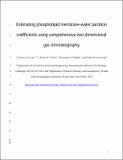| dc.contributor.author | Tcaciuc, Alexandra Patricia | |
| dc.contributor.author | Nelson, Robert Gregory | |
| dc.contributor.author | Reddy, Christopher M. | |
| dc.contributor.author | Gschwend, Philip M. | |
| dc.date.accessioned | 2013-05-17T19:28:54Z | |
| dc.date.available | 2013-05-17T19:28:54Z | |
| dc.date.issued | 2012-03 | |
| dc.date.submitted | 2012-02 | |
| dc.identifier.issn | 0013-936X | |
| dc.identifier.issn | 1520-5851 | |
| dc.identifier.uri | http://hdl.handle.net/1721.1/78926 | |
| dc.description.abstract | Recent studies have shown that membrane–water partition coefficients of organic chemicals can be used to predict bioaccumulation and type I narcosis toxicity more accurately than the traditional K[subscript OW]-based approach. In this paper, we demonstrate how comprehensive two-dimensional gas chromatography (GC × GC) can be used to estimate such membrane–water partition coefficients (K[subscript PLW]s), focusing in particular on phosphatidyl choline based lipids. This method performed well for a set of 38 compounds, including polycyclic aromatic hydrocarbons, polychlorinated benzenes and biphenyls, and substituted benzenes including some phenols and anilines. The average difference between the estimated and the measured log K[subscript PLW] values of 0.47 log units is smaller than in the case of a log K[subscript OW] correlation approach but larger than seen using a polyparameter linear free energy relationship based approach. However, the GC × GC based method presents the advantage that it can be applied to mixtures of chemicals that are not completely identified, such as petroleum hydrocarbon mixtures. At the same time, our application of the GC × GC method suffered larger errors when applied to certain hydrogen bonding compounds due to the inability of the GC × GC capillary columns phases that we used to interact with analytes via hydrogen bond donation/electron acceptance. | en_US |
| dc.description.sponsorship | Massachusetts Institute of Technology. Sea Grant College Program (NOAA Grant NA06OAR4170019) | en_US |
| dc.description.sponsorship | Massachusetts Institute of Technology. Sea Grant College Program (Project 2008-R/RC-109) | en_US |
| dc.description.sponsorship | Cooperative Institute for Coastal and Estuarine Environmental Technology (Award 015553-001) | en_US |
| dc.language.iso | en_US | |
| dc.publisher | American Chemical Society (ACS) | en_US |
| dc.relation.isversionof | http://dx.doi.org/10.1021/es203792e | en_US |
| dc.rights | Article is made available in accordance with the publisher's policy and may be subject to US copyright law. Please refer to the publisher's site for terms of use. | en_US |
| dc.source | Prof. Gschwend via Anne Graham | en_US |
| dc.title | Estimating Phospholipid Membrane Water Partition Coefficients Using Comprehensive Two-Dimensional Gas Chromatography | en_US |
| dc.type | Article | en_US |
| dc.identifier.citation | Tcaciuc, A. Patricia, Robert K. Nelson, Christopher M. Reddy, and Philip M. Gschwend. Estimating Phospholipid Membrane–Water Partition Coefficients Using Comprehensive Two-Dimensional Gas Chromatography. Environmental Science & Technology 46(6): 3449–3456, 2012. | en_US |
| dc.contributor.department | Massachusetts Institute of Technology. Department of Civil and Environmental Engineering | en_US |
| dc.contributor.department | Sloan School of Management | en_US |
| dc.contributor.approver | Gschwend, Philip | |
| dc.contributor.mitauthor | Tcaciuc, Alexandra Patricia | |
| dc.contributor.mitauthor | Nelson, Robert Gregory | |
| dc.contributor.mitauthor | Gschwend, Philip M. | |
| dc.relation.journal | Environmental Science and Technology | en_US |
| dc.eprint.version | Author's final manuscript | en_US |
| dc.type.uri | http://purl.org/eprint/type/JournalArticle | en_US |
| eprint.status | http://purl.org/eprint/status/PeerReviewed | en_US |
| dspace.orderedauthors | Tcaciuc, A. Patricia; Nelson, Robert K.; Reddy, Christopher M.; Gschwend, Philip M. | en |
| dc.identifier.orcid | https://orcid.org/0000-0002-9497-4492 | |
| mit.license | PUBLISHER_POLICY | en_US |
| mit.metadata.status | Complete | |
